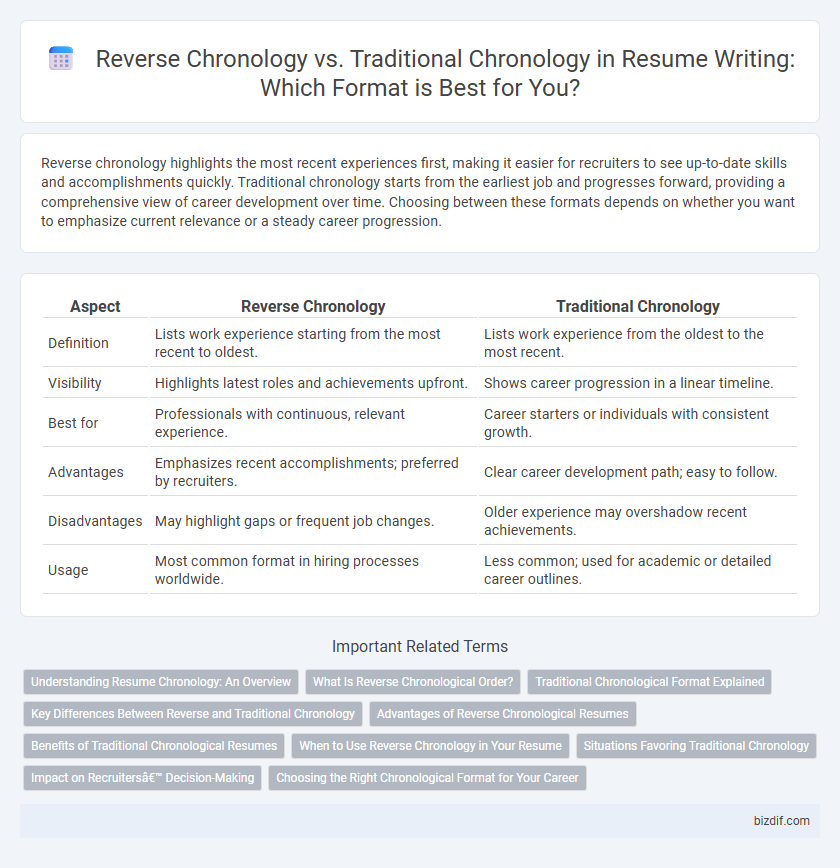Reverse chronology highlights the most recent experiences first, making it easier for recruiters to see up-to-date skills and accomplishments quickly. Traditional chronology starts from the earliest job and progresses forward, providing a comprehensive view of career development over time. Choosing between these formats depends on whether you want to emphasize current relevance or a steady career progression.
Table of Comparison
| Aspect | Reverse Chronology | Traditional Chronology |
|---|---|---|
| Definition | Lists work experience starting from the most recent to oldest. | Lists work experience from the oldest to the most recent. |
| Visibility | Highlights latest roles and achievements upfront. | Shows career progression in a linear timeline. |
| Best for | Professionals with continuous, relevant experience. | Career starters or individuals with consistent growth. |
| Advantages | Emphasizes recent accomplishments; preferred by recruiters. | Clear career development path; easy to follow. |
| Disadvantages | May highlight gaps or frequent job changes. | Older experience may overshadow recent achievements. |
| Usage | Most common format in hiring processes worldwide. | Less common; used for academic or detailed career outlines. |
Understanding Resume Chronology: An Overview
Resume chronology refers to the order in which work experience and education are presented, with reverse chronology listing the most recent positions first, while traditional chronology starts with the earliest. Reverse chronological resumes are preferred by employers for clearly showcasing career progression and current skills, making it easier to assess a candidate's most relevant experience. Traditional chronological resumes can be useful for highlighting long-term employment or career stability but may obscure recent achievements.
What Is Reverse Chronological Order?
Reverse chronological order in resume writing lists work experience starting with the most recent job and moving backward in time. This format highlights recent achievements and career progression, making it easier for employers to see the candidate's current skills and roles. It is the most widely used structure, especially effective for professionals with consistent work history in the same field.
Traditional Chronological Format Explained
The traditional chronological resume format organizes work experience starting with the most recent job and progressing backward in time, emphasizing a clear career progression. This format is preferred by employers for showcasing stable employment history and relevant experience within a specific industry. It effectively highlights promotions, consistent job growth, and long-term commitments, making it ideal for professionals with a steady work record.
Key Differences Between Reverse and Traditional Chronology
Reverse chronology arranges work experience starting with the most recent position, highlighting current skills and achievements, while traditional chronology lists jobs from the earliest to the latest, emphasizing career progression over time. Reverse chronological resumes are preferred by employers seeking quick insight into recent relevant experience, whereas traditional formats suit candidates with consistent career paths and limited gaps. Key differences include the direction of timeline, focus on recent versus overall work history, and adaptability to career changes or gaps.
Advantages of Reverse Chronological Resumes
Reverse chronological resumes highlight the most recent and relevant work experience first, significantly increasing the chances of capturing a recruiter's attention quickly. This format clearly showcases career progression and upward mobility, aiding employers in easily assessing a candidate's current skills and responsibilities. It is particularly advantageous for professionals with consistent work history or those seeking roles aligned with their latest experience.
Benefits of Traditional Chronological Resumes
Traditional chronological resumes highlight a clear career progression by listing work experience from oldest to newest, making it easier for employers to track job stability and growth over time. This format emphasizes long-term commitments and consistent skill development within specific industries or roles. Recruiters often prefer traditional chronological resumes because they provide an organized, straightforward timeline that simplifies background checks and reference verification.
When to Use Reverse Chronology in Your Resume
Reverse chronology is ideal for resumes when showcasing recent achievements and career progression clearly, emphasizing the most relevant and current work experience first. This format benefits professionals with continuous employment or significant recent roles that align closely with the job they are applying for. Candidates with frequent job changes or who are transitioning careers can also leverage reverse chronology to highlight their latest skills and accomplishments.
Situations Favoring Traditional Chronology
Traditional chronology benefits candidates with steady career progression and extensive experience in a single industry, as it highlights consistent growth and long-term commitments. It is particularly effective for those seeking roles within the same field, emphasizing reliability and deep expertise. Employers in conservative industries often prefer this format for its clarity and straightforward presentation of career history.
Impact on Recruiters’ Decision-Making
Reverse chronology highlights the most recent roles and achievements first, enabling recruiters to quickly assess current skills and relevance to the job. Traditional chronology provides a comprehensive career progression, helping recruiters understand long-term experience and growth patterns. Choosing the appropriate format can strategically influence a recruiter's evaluation by emphasizing either recent impact or overall career development.
Choosing the Right Chronological Format for Your Career
Selecting the right chronological format for your resume depends on your career trajectory and job goals. Reverse chronology highlights recent experience, making it ideal for professionals with consistent work history seeking to showcase current roles. Traditional chronology, starting from the earliest position, suits those with steady career progression or when emphasizing long-term industry expertise.
Reverse Chronology vs Traditional Chronology Infographic

 bizdif.com
bizdif.com